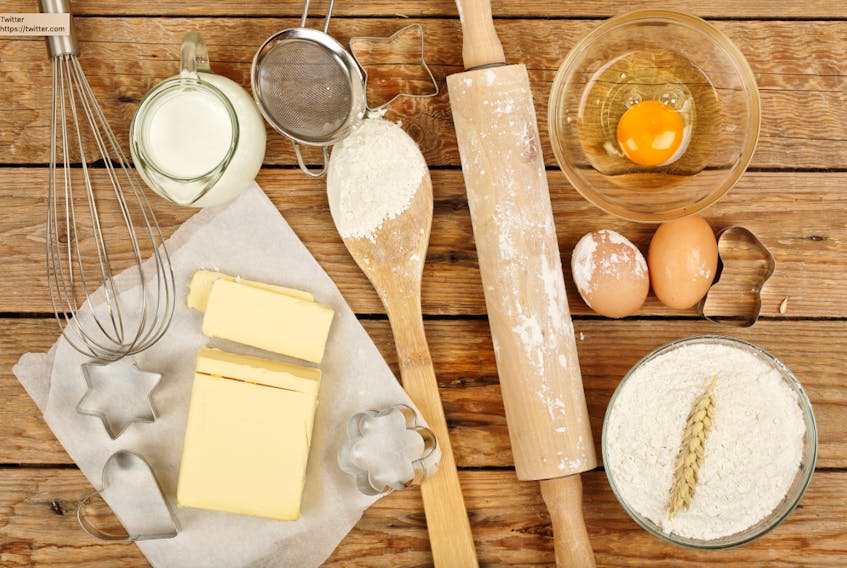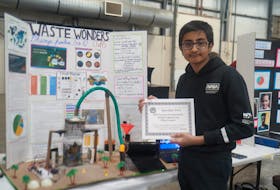My quest for the perfect rhubarb pie continues.
Change the filling, change the pastry, change the pie plate and see what happens.
The goal is to learn the skills that many of our mothers and grandmothers (and in some cases fathers and grandfathers) had, to bake pies that I can serve with confidence. It’s a DIY thing; I don’t want to rely on bakery pies, canned pie fillings or frozen pie shells.
Both the recipe and the technique have to be right in order to create a pie that meets the standards: baked, not soggy, bottom crust; pastry that cuts easily with a fork; minimal filling overflow; filling firm enough, when cool, to cut clean without being too firm and stodgy; crust and pastry that taste good together.
With advice from a friends and information from the internet, I’m getting closer to what I’m aiming for. You can find pictures of the two pies I made last week at Facebook.com/IslandGusto.
Getting the pastry right is the biggest challenge for me. I like pastry with a little taste of butter but have found that all-butter pastry can be tough, while pastry made with shortening or lard are more tender.
I tried an all-butter pastry (Seriouseats.com, Easy Pie Dough) that utilizes a non-standard technique for one pie last week and found it to be alright but not as tender as one that incorporated some shortening in the recipe. I think it is worth trying the all-butter one again, though.
A friend recommended a novel recipe that produced the more tender crust. It calls for a combination of butter and shortening (flavour and tenderness) and a bit of vodka. The vodka, they say, inhibits the formation of gluten and therefore keeps the pastry tender. It turned out tasty – no flavour of vodka – and tender.
Cook’s Illustrated’s Foolproof Pie Dough
Adapted from Seriouseats.com
625 mL (2½ cups) unbleached all-purpose flour
5 mL (1 tsp) table salt
25 mL (2 tbsp) sugar
1½ sticks (175 mL/¾ cup) cold unsalted butter, cut into 6 mm (¼ inch) slices
125 mL (½ cup) cold vegetable shortening, cut into 4 pieces
60 mL (¼ cup) cold vodka
60 mL (¼ cup) cold water
Process 375 mL (1½ cups) flour, salt and sugar in food processor until combined, about 2 one-second pulses. Add butter and shortening and process until homogeneous dough just starts to collect in uneven clumps, about 15 seconds (dough will resemble cottage cheese curds and there should be no uncoated flour). Scrape bowl with rubber spatula and redistribute dough evenly around processor blade. Add remaining flour and pulse until mixture is evenly distributed around bowl and mass of dough has been broken up, 4 to 6 quick pulses. Empty mixture into medium bowl.
Sprinkle vodka and water over mixture. With rubber spatula, use folding motion to mix, pressing down on dough until dough is slightly tacky and sticks together. Divide dough into two even balls and flatten each into 10 cm (4 inch) disk. Wrap each in plastic wrap and refrigerate at least 45 minutes or up to 2 days.
Makes 2 single crust or 1 double crust pie.
I used tapioca (40 mL (2 tbsp+2 tsp) per 1 L (4 cups) of rhubarb) rather than flour to thicken the filling this week, and there was very little overflow. I also added more venting than I usually do, cutting a circle from the centre of the top in addition to the usual vents radiating from the centre, to allow steam to escape and keep the filling inside the pie.
The opening in the centre also allowed me to see whether the filling in the middle was bubbling; until that happens, the pie is not done. I’ve found that it usually takes longer for my pies to bake than the time suggested in the recipes and that the type of pan influences the baking time.
While The Joy of Cooking recommended 230 C (425 F) for 10 minutes, followed by 35-40 minutes at 180 C (350 F), the pie baked in the metal pan required an additional 15 minutes, and the one in the glass pan took a total of 90 minutes at 180 C (350 F) to bake through.
It takes knowledge and repeated practise to bake good fruit pies. I’ll keep at it.
Margaret Prouse, a home economist, writes this column for The Guardian every Friday. She can be reached by email at [email protected].









